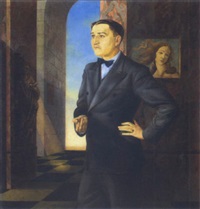Ernst-Adolf Schmorl

Ernst-Adolf Theodor Schmorl (born March 11, 1906 in Dresden , † March 29, 1964 in Wiesbaden ) was a German child and youth psychiatrist who was involved in Nazi euthanasia research.
Life
After graduating from high school in 1925, Schmorl studied medicine at the universities of Würzburg , Geneva , Leipzig , Vienna and Frankfurt am Main , which he completed in December 1930 with the state medical examination in Frankfurt am Main. After completing his studies at the municipal sanatorium and nursing home and the Friedrichstadt city hospital , he completed the practical part of his medical training in his home town. In mid-February 1932 he received his license to practice medicine and then worked as an assistant doctor in the Pirna-Sonnenstein sanatorium . With the thesis to assess the occupational therapy of schizophrenia clinical point of his doctorate he in 1933 at the Medical Faculty of the University of Leipzig Dr. med.
After the transfer of power to the National Socialists , Schmorl joined the NSDAP in May 1933 and became an associate judge at the Dresden Hereditary Health Court . During his activity at the sanatorium and nursing home in Pirna-Sonnenstein, he was promoted to the government medical council under the director of the institution Paul Nitsche .
After the beginning of the Second World War , Schmorl worked at the health department in Pirna from 1940 . He was also a camp doctor in the returnees camp for ethnic Germans on the premises of the Pirna-Sonnenstein killing center . From October 1941 to January 1942 he was deputy director under the director Gerhard Wischer at the Waldheim sanatorium. From January 1942 he worked under the psychiatrist Hans Heinze (head of the "research department" of the Brandenburg-Görden State Institute) in the Brandenburg-Görden State Institute. In July 1942 Heinze sent him to Heidelberg to see the psychiatrist Carl Schneider , where he took part in his euthanasia examinations ("research - kill - dissect"). In this context, Schmorl - like Johannes Suckow - was seconded at the end of 1942 to a "research department" set up by Schneider in the Wiesloch sanatorium , where disabled people were medically examined before they were murdered. The research department was dissolved at the end of March 1943 due to the war. Schmorl then found a job at the health department in Meißen .
After the end of the war, Schmorl worked as a senior physician at the Herborn asylum from 1951 and moved to Kalmenhof in Idstein in 1958 , where he was promoted to the state chief medical officer and worked as a child and youth psychiatrist.
literature
- Ernst Klee : The dictionary of persons on the Third Reich . Who was what before and after 1945 . 2nd Edition. Fischer-Taschenbuch-Verlag, Frankfurt am Main 2007, ISBN 978-3-596-16048-8 . , P. 551.
Web links
- Literature by and about Ernst-Adolf Schmorl in the catalog of the German National Library
Individual evidence
- ^ A b Ernst Klee: Das Personenlexikon zum Third Reich , Frankfurt am Main 2007, p. 551.
- ↑ Ernst Klee: What they did - What they became. Doctors, lawyers and others involved in the murder of the sick or Jews , Frankfurt am Main 2004, p. 175.
| personal data | |
|---|---|
| SURNAME | Schmorl, Ernst-Adolf |
| ALTERNATIVE NAMES | Schmorl, Ernst-Adolf Theodor (full name) |
| BRIEF DESCRIPTION | German child and youth psychiatrist, participant in Nazi euthanasia research |
| DATE OF BIRTH | March 11, 1906 |
| PLACE OF BIRTH | Dresden |
| DATE OF DEATH | March 29, 1964 |
| Place of death | Wiesbaden |